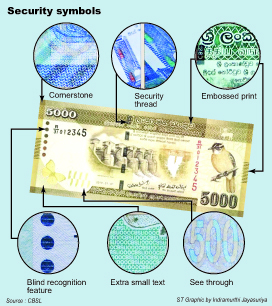News
Note of caution: Fake currency rackets on the rise
An increasing number of forged currency detections at petrol sheds, grocery shops, banks and other outlets countrywide have prompted not only big-time financial institutions but also small shop owners to invest in machines that detect forged currency, the Sunday Times learns.
As people become increasingly wary about big notes in the wake of recent detections, a private company has come forward to instal machines in public places for people to check whether their currency notes are genuine.
A top official of the company that imports the machines said many institutions dealing in cash were showing a keen interest in forged currency detecting machines and taking other measures to detect forged notes.
Last Sunday, police arrested a man who produced a fake thousand-rupee note to pay for fuel at a Weeraketiya filling station.
This incident followed the arrest of a soldier who allegedly printed fake notes. The Kegalle police who conducted the raid at his residence recovered faked currency notes that added upto Rs. 2.7 million. Among them were 520 notes in the denomination of Rs. 5,000, 10 notes in the denomination of Rs. 1,000. They also recovered a colour printer and a laptop.
The suspect was identified as 30-year-old Dileepa Kumara Abeysinghe, who is attached to the Beragala Army Camp.
Army Commander Daya Ratnayake has instructed senior officers to help the police in the investigations and to find out whether the suspect had accomplices in the Army.
On March 26, a man at Settikulam in Vavuniya was arrested when he tried to deposit fake 500 rupees in a bank. Days before this incident, a 40-year old man in Rideegama was arrested for possessing a counterfeit 2,000-rupee note.
Also last month, a 23-year-old man was arrested by the Pettah Police for possessing counterfeit notes in Rs. 5,000 denomination. In another case, Thulhiriya police arrested a man who tried to change a fake Rs. 5000 note at a shop. On being arrested, police found four more fake notes in the same denomination in his trouser pocket.
In a high profile case, the CID last month seized 400 counterfeit notes in Rs. 5,000 denomination while they were being deposited at a private bank in Cinnamon Gardens. The fake currencies were brought to the bank by Dulanjalee Jayakody, daughter of former president R. Premadasa. She was questioned for nine hours and released. She told police that the currency notes were given to her by a man with whom she had done business.
The police later arrested a garment factory owner and recovered 424 forged notes in Rs. 5,000 denomination and two printing machines from his house in Ethul Kotte. He was later released on bail.
The series of detections has also drawn the attention of the Central Bank, which is responsible for the country’s monetary policies.
A senior Central Bank official said the rate of detections indicated that more people were involved in fake currency scams than in the past.
She said that figures showed that there were six fake notes per every one million genuine note in circulation in Sri Lanka. “This is very low compared to other South Asian countries such as India and Pakistan,” she said.
The official added that the better way to minimise the printing of forged currency notes was to create awareness among the public on ways to identify fake notes.
She said the Central Bank had introduced different watermarks in every currency note to prevent forgery. These watermarks include different birds, the value in numeral that appears vertically, the cornerstone which appears in the form of diagonal stripes at all four corners of every currency note.
The security thread which has a colour-shifting feature from red to green differs from denomination to denomination and carries the letters CBSL and the value. The width of the starch-chrome thread in Rs. 5,000, Rs. 1,000 and Rs. 500 notes are 3 mm, 2.5 mm and 2 mm respectively.
According to detectives involved in the investigations, although counterfeiters have duplicated most of the security features of the genuine currency notes, none could duplicate the embossed print and the colour-changing feature.
A senior official of a leading private commercial bank said their branches detected around 50-100 counterfeit notes every month.
“There have been instances where we have failed to identify the fake notes during transactions. Such notes, however, eventually get identified during the cash sorting process at the head office and these notes are handed over to the CID as per Central Bank guidelines.”
Asked how a bank would deal with a depositor who had no knowledge that he was carrying a fake note, the official said: “If a note suspected to be a counterfeit is detected at a bank branch, it will be brought to the notice of the customer. The note will not be returned to the customer under any circumstances. As per CBSL guidelines, the bank has to obtain the details of the depositor on a prescribed format. The note and the form filled and signed by the depositor will then be sent to the head office,” she added.
However, if bank officials felt there was a willful attempt to introduce forged notes into circulation, the matter would be immediately informed to the police after consulting the head office, the official said adding that the bank could also inform the Counterfeit Currency Bureau of the CID and act on their advice.

